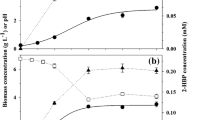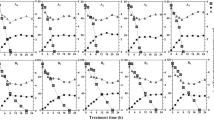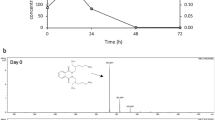Abstract
As several authors have reported previously, the Biodesulfurization of hydrodesulfurization recalcitrants, such as dibenzothiophene, is not yet commercially viable because mass transfer limitations and feedback inhibition effects are produced during the conversion. This work has been focused to investigate the inhibition process in aqueous and oil-water systems with two different aerobic biocatalysts types, Rhodococcus erythropolis IGTS8 and Pseudomonas putida CECT 5279. The results obtained have proven that global DBT desulfurization process using CECT 5279 was not clearly deactivated due to final product accumulation, under the experimental conditions assayed. Consistently, the desulfurization pattern has been described with the Michaelis-Menten equation, determining the kinetic parameters. On other hand, the assays have shown that important mass transfer limitations produced the decrease of the yields obtained with this Gram− strain in biphasic media. With strain IGTS8 it was observed lower mass transfer problems, but contrary the reaction was severely affected by the final product accumulation, in both aqueous and biphasic systems. Therefore it has been proposed an enzymatic kinetic model with competitive inhibition to describe the BDS evolution pattern when this Gram+ strain was used.








Similar content being viewed by others
Abbreviations
- BDS:
-
Biodesulfurization
- C:
-
Concentration (μM)
- DBT:
-
Dibenzothiophene
- DBTO:
-
DBT-sulfoxide
- DBTO2 :
-
DBT-sulfone
- DC:
-
Dry cell
- HBP:
-
2-hydroxybiphenyl
- HBPSi:
-
2′-hydroxybephenyl-2-sulfinate
- HDS:
-
Hydrodesulfurization
- I:
-
Inhibitor concentration (μM of HBP)
- K:
-
Kinetic constant (μM)
- P:
-
Product (HBP) concentration (μM)
- qS :
-
Specific substrate consume rate (mmol substrate·KgDC−1 h−1)
- S:
-
Substrate concentration (μM)
- X:
-
Biomass concentration (g DC L−1)
- XBDS :
-
Biodesulfurization percentage (%)
- y:
-
Fitting model parameter
- i:
-
Intermediate
- I:
-
Inhibition over main substrate
- I′:
-
Inhibition over intermediate substrate
- max:
-
Maximum
- r:
-
Remove
- S:
-
Substrate, saturation
References
Abbad-Andaloussi S, Lagnel C, Warzywoda M, Monot F (2003) Multi-criteria comparison of resting cell activities of bacterial strains selected for biodesulfurization of petroleum compounds. Enz Microbiol Technol 32(3–4):446–454
Alcon A, Santos VE, Martin AB, Yustos P, García-Ochoa F (2005) Biodesulfurisation of DBT with Pseudomonas putida CECT5279 by resting cells: influence of cell growth time on reducing equivalent concentration and HpaC activity. Biochem Eng J 26:168–175
Caro A, Boltes K, Letón P, Garcia-Calvo E (2007) Dibenzothiophene biodesulfurization in resting cell conditions by aerobic bacteria. Biochem Eng J 35(2):191–197
Chang JH, Chang YK, Ryu HW, Chang HN (2000) Desulfurization of ligth gas oil in immobilized-cell systems of Gordona sp. CYKS1 and Nocardia sp. CYKS2. FEMS Microbiol Lett 182:309–312
Feng J, Zeng Y, Ma C, Cai X, Zhang Q, Tong M, Yu B, Xu P (2006) The surfactant Tween 80 enhances biodesulfurization. Appl Environ Microbiol 72(11):7390–7393
Gallagher JR, Olson ES, Stanley DC (1993) Microbial desulfurization of dibenzothiophene: a sulfur-specific pathway. FEMS Microbiol Lett 107:31–36
Gallardo ME, Ferrandez A, De Lorenzo V, Garcia JL, Diaz E (1997) Designing recombinant Pseudomonas strains to enhance biodesulfurization. J Bacteriol 179:7156–7160
Gray KA, Pogrebinsky OS, Mrachko T, Xi L, Monticello DJ, Squires CH (1996) Molecular mechanisms of biocatalytic desulfurization of fossil fuels. Nat Biotechnol 14:1705–1709
Guchhait S, Biswas D, Bhattacharya P, Chowdhury R (2005) Bio-desulfurization of model organo-sulfur compounds and hydrotreated diesel- Experiments and modelling. Chem Eng J 112:145–151
Guobin S, Huaiying Z, Jianmin X, Guo C, Wangliang L, Huizhou L (2006) Biodesulfurization of hydrodesulfurized diesel oil with Pseudomonas delafieldii R-8 from high density culture. Biochem Eng J 27(3):305–309
H del Olmo C, Alcon A, Santos VE, García-Ochoa F (2005a) Modeling the production of a Rhodococcus erythropolis IGTS8 biocatalyst for DBT biodesulfurization: influence of media composition. Enz Microbiol Technol 37:157–166
H del Olmo, C, E Santos, V, Alcon, A, García-Ochoa, F (2005b) Production of a Rhodococcus erythropolis IGTS8 biocatalyst for DBT biodesulfurization: influence of operational conditions. Biochem Eng J 22:229–237
Honda H, Sugiyama H, Saito I, Kobayashi T (1998) High cell density culture of Rhodococcus rhodochrous by pH-stat feeding and dibenzothiophene degradation. J Ferment Bioeng 85(3):334–338
Jia X, Wen J Sun Z, Caiyin Q, Xie S (2006) Modelling of DBT biodegradation behaviors by resting cells of Gordonia sp. WQ-01 and its mutant in oil-water dispersions. Chem Eng Sci 61(6):1987–2000
Kilbane II JJ (2006) Microbial biocatalyst development to upgrade fossil fuels. Curr Opin Biotechnol 17:305–314
Kilbane JJ, Jackowski K (1992) Biodesulfurization of water soluble coal-derived material by Rhodococcus rhodochrous IGTS8. Biotechnol Bioeng 40:1107–1114
Kobayashi M, Horiuchi K, Yoshikawa O, Hirasawa K, Ishii Y, Fujino K (2001) Kinetic analysis of microbial desulfurization of model and light gas oils containing multiple alkyl dibenzothiophenes. Biosci Biotechnol Biochem 65(2):298–304
Konishi J, Ishii Y, Onaka T, Okumura K, Suzuki M (1997) Thermophilic carbon-sulfur-bond-targeted biodesulfurization. Appl Environ Microbiol 63(8):3164–3169
Le Borgne S, Quintero R (2003) Biotechnological processes for the refining of petroleum. Fuel Process Technol 81:155–169
Luo MF, Xing JM, Gou ZX, Li S, Liu HZ, Chen JY (2002) Desulfurization of dibenzothiophene by lyophilized cells of Pseudomonas delafieldii R-8 in the presence of dodecane. Biochem Eng J 13(1):1–6
Maghsoudi S, Vossoughi M, Kheirolomoom A, Tanaka E, Katoh S (2001) Biodesulfurization of hydrocarbons and diesel fuels by Rhodococcus sp. strain P32C1. Biochem Eng J 8:151–156
Martin AB, Alcón A, Santos VE, García-Ochoa F (2004) Production of a biocatalyst of Pseudomonas putida CECT5279 for Dibenzothiophene (DBT) Biodesulfurization for different media composition. Energy Fuels 18:851–857
McFarland BL (1999) Biodesulfurization. Curr Opin Microbiol 2:257–264
Monticello DJ (1998) Riding the fossil fuel biodesulfurization wave. Chemtec 28:38–45
Monticello DJ (2000) Biodesulfurization and the upgrading of petroleum distillates. Curr Opin Microbiol 11:540–546
Monticello DJ, Finnerty WR (1985) Microbial desulfurization of fossil fuels. Ann Rev Microbiol 39:371–389
Ohshiro T, Izumi Y (1999) Microbial desulfurization of organic sulfur compounds in petroleum. Biosci Biotechnol Biochem 63(1):1–9
Ohshiro T, Hine Y, Izumi Y (1994) Enzymatic desulfurization of dibenzothiophene by a cell-free system of Rhodococcus erythropolis D-1. FEMS Microbiol Lett 118:341–344
Ohshiro T, Hirata T, Hashimoto I, Izumi Y (1996) Characterization of DBT desulfurization reaction by whole cells of Rhodococcus erythropolis H-2 in the presence of hydrocarbon. J Ferment Bioeng 82(6):610–612
Ohshiro T, Ishii Y, Matsubara T, Ueda K, Izumi Y, Kina K, Kirimura K (2005) DBT desulfurizing enzymes from moderately thermophilic bacterium Bacillus subtilis WU-S2B: purification, characterization and overexpression. J Biosci Bioeng 100(3):266–273
Oldfield C, Pogrebinsky O, Simmonds J, Olson ES, Kulpa CF (1997) Elucidation of the metabolic pathway for dibenzothiophene desulphurization by Rhodococcus sp. strain IGTS8 (ATCC 53968). Microbiol 143:2961–2973
Oldfield C, Wood NT, Gilbert SC, Murray FD, Faure FR (1998) Desulfurisation of benzothiophene and dibenzothiophene by actinomicete organisms belonging to the genus Rhodococcus, and related taxa. Antonie Van Leeuwenhock 74:119–132
Olson E, Stanley D, Gallagher J (1993) Characterization of intermediates in the microbial desulfurization of dibenzothiophene. Energy Fuels 7:159–164
Omori T, Monna L, Saiki Y, Kodama T (1992) Desulfurization of dibenzothiophene by Corynebacterium sp. strain SY-1. Appl Environ Microbiol 58:911–915
Rashtchi M, Mohebali GH, Akbarnejad MM, Towfighi J, Rasekh B, Keytash A (2006) Analysis of biodesulfurization of model oil system by the bacterium, strain RIPI-22. Biochem Eng J 29(3):169–173
Takada M, Nomura N, Okada H, Nakajima-Kambe T, Nakahara T, Uchiyama H (2005) De-repression and comparison of oil watr seperation activity of the dibenzothiophene desulfurizing bacterium, Mycobacterium sp. G3. Biotechnol Lett 27:871–874
Tao F, Yu B, Xu P, Ma CQ (2006) Biodesulfurization in biphasic system containing organic solvents. Appl Environ Microbiol 72(7):4604–4609
Wang P, Humphrey AE, Krawiec S (1996) Kinetic analyses of desulfurization of dibenzothiophene by Rhodococcus erythropolis in continuous cultures. Appl Environ Microbiol 62(8):3066–3068
Watkins LM, Rodriguez R, Schneider D, Broderick R, Cruz M, Chambers R, Ruckman E, Cody M, Mrachko GT (2003) Purification and characterization of the aromatic desulfinase, 2-(2′-hydroxyphenyl)benzenesulfinate desulfinase. Arch Biochem Biophys 415:14–23
Xu P, Yu B, Li FL, Cai XF, Ma CQ (2006) Microbial degradation of sulphur, nitrogen and oxygen heterocycles. Trends Microbiol 14(9):398–405
Yan H, Kishimoto M, Omasa T, Katakura Y, Suga K, Okumura K, Yoshikawa O (2000) Increase in desulfurization activity of Rhodococcus erythropolis KA2-5-1 using ethanol feeding. J Biosci Bioeng 89(4):361–366
Yang J, Marison IW (2005) Two-stage process design for the biodesulphurisation of a model diesel by a newly isolated Rhodococcus globerulus DAQ3. Biochem Eng J 27:77–82
Acknowledgements
This work has been supported by MEC-Plan Nacional de I + D-Programa de Ciencia y Tecnología Química, under contract no. CTQ2004-06553-C02-02.
Author information
Authors and Affiliations
Corresponding author
Rights and permissions
About this article
Cite this article
Caro, A., Boltes, K., Letón, P. et al. Description of by-product inhibiton effects on biodesulfurization of dibenzothiophene in biphasic media. Biodegradation 19, 599–611 (2008). https://doi.org/10.1007/s10532-007-9165-z
Received:
Accepted:
Published:
Issue Date:
DOI: https://doi.org/10.1007/s10532-007-9165-z




